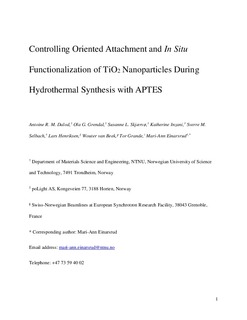| dc.contributor.author | Dalod, Antoine Robert Marie | |
| dc.contributor.author | Grendal, Ola Gjønnes | |
| dc.contributor.author | Skjærvø, Susanne Linn | |
| dc.contributor.author | Inzani, Katherine | |
| dc.contributor.author | Selbach, Sverre Magnus | |
| dc.contributor.author | Henriksen, Lars | |
| dc.contributor.author | van Beek, Wouter | |
| dc.contributor.author | Grande, Tor | |
| dc.contributor.author | Einarsrud, Mari-Ann | |
| dc.date.accessioned | 2017-09-26T07:20:13Z | |
| dc.date.available | 2017-09-26T07:20:13Z | |
| dc.date.created | 2017-06-01T09:24:25Z | |
| dc.date.issued | 2017 | |
| dc.identifier.citation | Journal of Physical Chemistry C. 2017, 121 (21), 11897-11906. | nb_NO |
| dc.identifier.issn | 1932-7447 | |
| dc.identifier.uri | http://hdl.handle.net/11250/2456643 | |
| dc.description.abstract | Understanding growth mechanisms and the role of surface functionalization is of key importance to control shape and morphology of nanoparticles and their properties. Here, we describe the growth mechanism and the effect of hydrothermal synthesis parameters (pH, time, and precursor/functionalization agent ratio) during in situ functionalization of anatase TiO2 nanoparticles with 3-aminopropyltriethoxysilane. Elongated crystallographically oriented TiO2 nanoparticles were formed by oriented attachment mechanism in addition to spherical nanoparticles. The growth mechanism is determined by a combination of ex situ techniques such as high-resolution transmission electron microscopy combined with in situ synchrotron X-ray diffraction and density functional theory calculations. Oriented attachment induced by the functionalization agent is shown to be the origin of the elongation of the nanoparticles, as only spherical nanoparticles were formed in the absence of surface functionalization. Finally, it was shown that the amount and the size of the elongated nanoparticles can be tuned by adjusting pH. | nb_NO |
| dc.language.iso | eng | nb_NO |
| dc.publisher | American Chemical Society | nb_NO |
| dc.title | Controlling Oriented Attachment and in Situ Functionalization of TiO2 Nanoparticles During Hydrothermal Synthesis with APTES | nb_NO |
| dc.type | Journal article | nb_NO |
| dc.type | Peer reviewed | nb_NO |
| dc.description.version | acceptedVersion | nb_NO |
| dc.source.pagenumber | 11897-11906 | nb_NO |
| dc.source.volume | 121 | nb_NO |
| dc.source.journal | Journal of Physical Chemistry C | nb_NO |
| dc.source.issue | 21 | nb_NO |
| dc.identifier.doi | 10.1021/acs.jpcc.7b02604 | |
| dc.identifier.cristin | 1473385 | |
| dc.relation.project | Norges forskningsråd: 235210 | nb_NO |
| dc.relation.project | Notur/NorStore: NN9264K | nb_NO |
| dc.description.localcode | This is the authors' accepted and refereed manuscript to the article. Locked until 2 May 2018 due to copyright restrictions | nb_NO |
| cristin.unitcode | 194,66,35,0 | |
| cristin.unitname | Institutt for materialteknologi | |
| cristin.ispublished | true | |
| cristin.fulltext | postprint | |
| cristin.qualitycode | 1 | |
